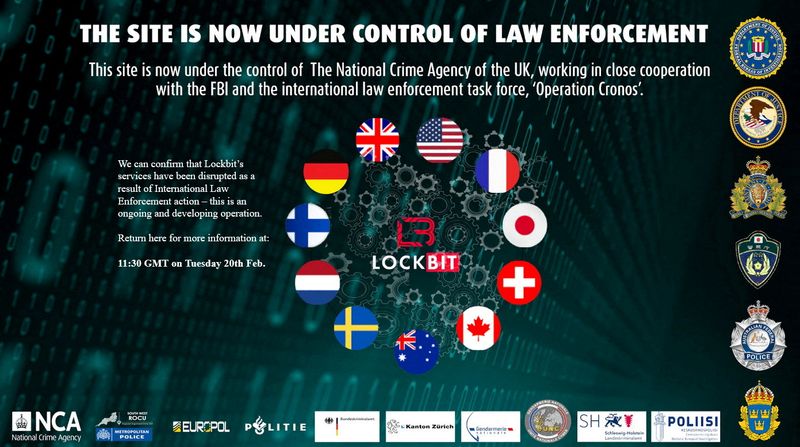Month: February 2024
Lockbit crackdown heats up as US offers reward for info on hackers
Post Content
Largest South Korean Parties Promise Bitcoin ETFs Before Election
The below is an excerpt from a recent edition of Bitcoin Magazine Pro, Bitcoin Magazine’s premium markets newsletter. To be among the first to receive these insights and other on-chain bitcoin market analysis straight to your inbox, subscribe now.
As South Korea approaches its next legislative election in 2024, both the current ruling party and the main opposition have pledged to make several pro-Bitcoin policies, most especially to approve a Bitcoin ETF.
On April 10, 2024, The Republic of Korea will carry out its legislative election, which takes place every four years. Regardless of outcome, the President will not change, as they serve five-year terms and are thus elected by entirely separate procedures, thanks to a quirk of South Korea’s constitution. In fact, leading into this election, the party which controls the majority of seats does not hold the nation’s highest office, and will not have the opportunity to contest this until 2027. Nevertheless, one fact makes these distinctions less critical from the Bitcoiner’s perspective: both parties have made the unusual step of making similar pledges to support Bitcoin.
Although there are theoretically 6 different parties contesting for 300 seats in this election, 4 of these each hold single-digit numbers. The two real contenders are the conservative People Power Party (PPP), which currently holds the presidency, and the more liberal Democratic Party (DPK) which currently holds 50 more seats. What’s more, polling currently supports a favorable outcome for the DPK, leading to an unenviable possibility where People Power may hold the leading office and virtually zero ability to pass legislation. It’s likely for these reasons that the party chose to embrace radical new incentives, and that’s where Bitcoin comes in.
Rumors of a pro-Bitcoin turn for PPP first materialized on February 19, 2024, when its representatives made comments to a local newspaper that a more comprehensive framework for crypto regulation needed to become a priority. Until this new framework exists, they alleged, it may be the most prudent option to eliminate all capital gains taxes on Bitcoin or other cryptocurrency until relevant legislation could be hammered out and signed. Legislation like this would be a difficult undertaking, however, and PPP spokespeople claimed that it may be necessary to continue such a tax pause for two years. This seems like a particularly clumsy attempt at fishing for votes, especially considering that these taxes are currently in a state of limbo, but it was not the only effort.
The PPP went on to state that same day that the party was considering a broad range of pro-Bitcoin options, particularly by loosening a series of restrictions on institutional investment. Not only did they pledge to create a “Digital Asset Promotion Committee” with special authority over digital asset regulation, the PPP also made several vague statements on several specific policy reforms, particularly the crown jewel: a Bitcoin Spot ETF. It was broadly speculated that these vague promises were a cynical move intended to attract flagging youth support, especially considering that data from the National Tax Agency claims that 80% of crypto users are in the 20-39 age bracket. These moves may have been undertaken with little true affinity for Bitcoin, but the next development overturned the entire situation.
The following day, the opposition stole PPP’s thunder when the DPK made several concrete pledges, most especially to allow individual investors access to Bitcoin ETFs. Their plan specifically declares that these purchases will have to go through an individual savings account, and therefore corporate interests will be unable to use it for serious multibillion dollar trades. The DPK also made several more vague allusions about removing other barriers to institutional legislation, but announced that a comprehensive proposal to “vitalize and institutionalize” the digital asset space will be released on Wednesday, February 21st. These political upsets led the PPP to respond in kind by upgrading their general pro-Bitcoin comments into definite campaign promises.
This presents us with a most unusual situation: regardless of the political establishment’s true feelings on Bitcoin or any other digital asset, the need to win youth support in a particularly contentious election has made either choice the pro-Bitcoin option. But how likely are these politicians to follow through, and what would it look like for South Korea? To answer these questions, it’s important to look at a few fundamentals in their overall economy. By all accounts, it’s doing pretty well: although South Korea has recently experienced inflation, with their monetary supply at the highest level since 1970 during Q4 of last year, this figure has calmed down significantly. Further, its Consumer Price Index (CPI) has also relaxed over the past few months, showing that the cost of goods such as housing, food or electricity have been declining in turn.
An environment like this does generally rule out one of the most prominent use-cases for Bitcoin adoption worldwide, namely its use as a store-of-value. It seems unlikely that large numbers of South Koreans will seek to maintain significant savings in won, nor are they likely to use it for international remittances. However, South Korea does nevertheless have several distinct advantages as a possible new Bitcoin hub. In 2022, an estimated 4% of South Koreans held various digital assets, although this number was markedly growing. Less than 14% of Americans held any in the same period. In other words, mass adoption has not been a significant barrier to the US status as a worldwide center for Bitcoin, with its vast array of active developers and revolutionary blockchain projects, and it likely won’t present an obstacle for South Korea either. South Korea is a developed economy with a strong tech sector, and its stable inflation will be a necessary requirement for a certified digital asset industry emerging.
There is one crucial point in South Korea’s favor, additionally: as both major parties have pointed out, Bitcoin enjoys enthusiastic popularity among the nation’s youth. Not only has the country with its dense population centers enjoyed a high level of internet connectivity for decades, Millennials have a living memory of a currency crisis in 1997, which led South Korea to turn to bailouts from the IMF. These factors especially have led a growing number of Korean youths to show interest for an alternate economic vision, and Bitcoin has been there to supply that vision. The number of Bitcoiners may be small, but there are several reasons to believe that it could become a fertile ground for future development.
In other words, it’s very possible that the pro-Bitcoin initiatives endorsed by both parties will be able to trigger a real maturation for the young industry. Between the two sets of pledges, it seems at first glance that the DPK’s might prove more useful in this respect: their ETF proposal is not an invitation for the financial establishment to dominate the market, and their upcoming framework is explicitly intended to empower a new domestic industry. Nevertheless, the PPP’s proposal is also encouraging, and its plan to create a regulatory body for crypto can also provide many opportunities.
No matter how you slice it, Bitcoin has been taking the world by storm ever since the US approved the spot ETF, and countries are falling like dominoes to enact similar pro-Bitcoin legislation. South Korea’s close neighbor, Japan, has even considered taking steps to foster their own industry. Regardless of how the nation decides to swing between their two main political options, it’s clear that the decision on Bitcoin has already been made. We can look to a golden new opportunity coming for South Korea, and the knowledge that Bitcoin’s strength may create similar opportunities elsewhere. After all, the way Bitcoin’s been growing, success like this could come anywhere. No matter where you are, it may come to pass that you’re asked to choose between Bitcoin and Bitcoin, and that makes for one sure bet.
Bolivia unveils measures to tackle sharpening dollar crisis
Post Content
Dollar just higher ahead of Fed minutes; euro awaits confidence data
Post Content
Asia FX retakes some ground as dollar retreats before more Fed cues
Post Content
What Is Multisig?
When it comes to storing your bitcoin, multisignature—or multisig for short—is widely recognized as one of the most secure methods. It can eliminate risks associated with exchanges and custodians, and simultaneously addresses the most common issues with self-custody. In this article, we’re going to walk through why you should hold your own bitcoin keys, what standard singlesignature self-custody looks like, and how multisig is an improvement for long-term cold storage.
Why Should I Self-custody?
Interest in bitcoin usually begins with recognizing it as an alternative monetary tool that remedies some of the clear dangers of conventional money, such as inflation, censorship, and confiscation. As motivation grows for transferring wealth into bitcoin, people are immediately faced with the decision of how to safely store it.
The first piece of advice you might hear is to avoid custodial solutions. The reason for this is simple: custodians of fiat currencies like the U.S. dollar (banks, brokerages, etc) can offer certain guarantees that custodians of bitcoin cannot. For example, government programs like the FDIC and SIPC provide insurance for when a custodian loses client deposits, and this obligation can always be met. Bitcoin has a strict supply limit—21 million coins—and new units can never be arbitrarily issued to replace coins that are lost by an irresponsible or malicious custodian.
Avoiding a custodian implies taking self-custody. In the world of bitcoin, custody is determined by who controls the private keys, because the private keys are the tools required to spend bitcoin. If you have purchased bitcoin on an exchange and haven’t withdrawn it to your own custody controlled by your own keys, then the bitcoin remains controlled by the exchange’s keys, and all you have is an IOU, rather than actual bitcoin. As the popular saying goes, “not your keys, not your bitcoin.”
Click this image to visit unchained.bitcoinmagazine.com for details on our collaborative custody partnership.
Holding your own keys simply means protecting secretive information, because that’s what a private key is: randomly generated data that should be kept private, and cannot realistically be guessed by anyone else. Generating a private key is easy, and can be done on a laptop or a phone app, but it is preferable to use a hardware wallet so that you can have confidence your key was never exposed to the internet. Check out some of our other articles to learn more about the reasons to use hardware wallets, and some of the best device models.
It is completely normal to feel apprehensive about holding your own bitcoin keys. People often lose information such as passwords, or physical items such as sunglasses and car keys. If you are worried that you might lose your bitcoin keys and therefore also lose access to your funds, that is a valid concern! However, multisig can help you rest easy knowing that you have backup plans in the event that you make a mistake and lose some information.
First, what is singlesig?
To understand multisig, it’s important to first understand the predecessor method of bitcoin storage: singlesig.
A singlesig wallet is the simplest and most widely used form of self-custody bitcoin wallet. It involves just one master private key, which can generate addresses for receiving bitcoin. If bitcoin is sent to one of those addresses, the amount will be counted towards the wallet balance, and it can only be removed from the wallet after approval from someone who has the private key.
A few examples of wallets commonly used as “singlesig”
The private key holder can demonstrate approval for a withdrawal by using the private key to cryptographically sign the transaction. You can imagine this like a physical signature being applied to a document that specifies the transaction details, in a verifiably unique way that can’t be forged. This is done within your software wallet, or for bitcoin in cold storage, within a hardware wallet. Then the signed transaction can be broadcast to the bitcoin network, where it will only be recognized as valid if the correct signature was applied.
Singlesig wallets have the benefit of being simple to set up, as well as providing fairly quick and easy access to withdrawing funds. Singlesig transaction fees can also cost less than multisig.
However, a major drawback to singlesig is that it always involves a single point of failure. Specifically, there are two glaring issues:
Vulnerability to theft: If your private key is exposed to someone else, that person may have what they need to steal your bitcoin.
Vulnerability to loss: If you lose your private key information (due to negligence or a natural disaster), you can lose the ability to spend your bitcoin, meaning you effectively no longer own it.
Various mechanisms have been created in an attempt to mitigate these concerns. Introducing tools such as BIP 39 passphrases or Seed XOR into a singlesig setup can help address the first issue, but they come with the trade-off of exacerbating the second issue. Another tool called Shamir’s Secret Sharing can create an improvement on both ends, but a single point of failure will still exist when it comes time to sign a transaction.
As a result, many people turn to multisig as the gold standard for removing single points of failure.
How is multisig different?
While bitcoin secured by singlesig requires one signature from one specific private key to spend funds, this is just the beginning of what bitcoin makes possible. A multisignature bitcoin wallet, as the name suggests, is a method of securing bitcoin that can require signatures from multiple private keys in order to spend the bitcoin. A subset of those keys are needed to sign off on spending any bitcoin that has been received into that arrangement.
This structure is popularly described as an m-of-n quorum. The “m” represents the number of private keys that are required to sign for a withdrawal to become valid, while the “n” represents the number of private keys that exist which can produce one of the required signatures.
An “m-of-n” quorum representing the keys required to sign and the total number of keys in the multisig setup.
For example, a 2-of-2 quorum indicates that there are two different private keys involved, and signatures from both keys are required to withdraw bitcoin that was received into that arrangement. This idea might be familiar to you if you have ever used a safety deposit box at a bank. Typically, these boxes require two keys to be opened, one of which is held by you, and the other is held by the bank. There are also ancient examples of similar approaches.
Alternatively, you could create a 1-of-2 quorum, where only one out of the two keys involved is needed to approve a spend. Or you could create a quorum that involves more than two keys, such as a 2-of-3. This would mean that three keys exist in the setup and any combination of two of them can sign off on spending bitcoin.
Multisig quorums are customizable to meet the needs of the user, so it can be extended to almost any quorum you could imagine—5-of-6, 2-of-9 or other complex setups. However, some quorums are dramatically more popular than others. 2-of-3 and 3-of-5 are by far the most widely used arrangements for securing bitcoin in cold storage, for reasons that we’ll cover below.
The most common bitcoin quorums: 2-of-3 and 3-of-5. Both strike a balance between complexity and security.
Why use multisig?
Switching from singlesig to multisig means introducing more keys, and therefore additional complexity. Is it worth it? Let’s take a look at some of the advantages and disadvantages.
Upgraded security
Earlier we discussed some of the biggest concerns that come with using singlesig. These included single points of failure, such as your private key being exposed, lost, or destroyed. How can multisig help?
With certain multisig quorums, redundancy is added to ensure that there’s no one thing that, if it breaks or stops working, will cause you to lose your money. You can rest easy knowing that if one of your private keys is exposed to someone, they will not have all the pieces needed to steal your bitcoin. Additionally, if one of your keys is lost or destroyed, you can still recover your bitcoin by using the remaining keys in your possession to transfer funds into a new wallet where you once again have all the pieces.
However, not all multisig quorums offer these protections. A “1-of-n” quorum (such as 1-of-2 or 1-of-5) does not provide adequate resistance to theft, because if any one of the keys is exposed to someone, that person may have what they need to steal bitcoin from you (they still need the associated multisig file). On the other hand, an “n-of-n” quorum (such as 2-of-2 or 5-of-5) would imply that if any one of the several keys are lost or destroyed, you will no longer be able to spend your bitcoin.
Setups that fit in between these two extremes are the sweet spot for addressing both categories of single points of failure: loss and theft. The least complex arrangement that satisfies both goals is 2-of-3, which is also the most popular multisig quorum for securing bitcoin in cold storage, and the only one we use at Unchained. A 3-of-5 quorum is a fairly popular arrangement as well, but it introduces more complexity than necessary for most situations. While 3-of-5 can provide extra redundancy, this point can be repeated to advocate for 4-of-7, and then 5-of-9, and so forth to infinity.
Some arrangements disproportionately expose you to risk of theft, while others expose you to risk of loss. 2-of-3 multisig protects you from both with the least amount of added complexity.
If you want to get the most out of the protections offered by a multisig arrangement, you should store all of your different keys in geographically separated locations, so that no two keys can be lost or exposed at the same time. The less complicated your multisig setup is, the easier it will be to create an effective system for keeping your keys secure and separated. You can read more about the trade-offs between 2-of-3 and 3-of-5 in our deeper dive on the topic.
Additional applications
Besides offering new custody options for individuals, multisig can open the door for serving the needs of groups of people. By creating a structure where different people hold different keys within the multisig quorum, some attractive possibilities become available. Let’s briefly cover a couple examples.
Treasury management
If a business, government or other organization wishes to hold bitcoin intelligently, multisig is all but required. Not only because of the increased security, but also to ensure that the people within the organization have the appropriate level of power to spend funds on behalf of the group.
Suppose a committee or legislative council consists of 9 people, and this group will be responsible for managing a bitcoin treasury. If each member of the group secures a private key, they can customize their structure so that a particular threshold of members must sign off on a treasury withdrawal. Spending funds could require a small portion of the group (3-of-9), or a majority (5-of-9), or even a supermajority (6-of-9).
Special members of a group like this could also possess additional power to spend funds, if they hold additional keys within the chosen quorum.
Trust-minimized collateral
Many bitcoin holders want to exercise the purchasing power of their bitcoin without selling it, which could result in capital gains taxes as well as missing out on future increases in value.
A popular solution to this dilemma is a bitcoin-backed loan, usually built with a 2-of-3 multisig quorum. A bitcoin holder can borrow cash from a lender after depositing their bitcoin into the multisig wallet, where the borrower keeps one key, the lender holds one key, a third party arbitrator holds one key, and two keys are required to withdraw bitcoin from the wallet.
Some multisig arrangements allow three parties to share custody to enable things like secure collateralized loans.
Once the loan is repaid, the borrower and lender can use their keys to sign off on returning the bitcoin to the borrower’s full control. If the loan is not repaid, the bitcoin can be transferred to the lender’s full control. If there is a dispute, or either participant is noncooperative, the arbitrator can review the situation and assist the justified party.
With this model, stealing funds would have to involve collusion between two key holders, destroying the reputations of both entities. This structure is referred to as “trust-minimized,” a substantial improvement over putting complete trust in a single custodian. It also ensures that the bitcoin is not being rehypothecated and remains available to be moved into the full custody of the rightful owner at any time.
Bitcoin-backed loans are a service offered by Unchained, and you can learn about specifics here.
Click above to visit unchained.bitcoinmagazine.com and receive $100 off Unchained’s IRA product with code “BTCMAG”
Trade-offs with multisig
As noted earlier, there are a couple of trade-offs when using multisig compared to singlesig.
First is the obvious increase in complexity that comes with incorporating more keys into the custody arrangement. With more keys, there are more items to keep track of, and each item will ideally be kept in separate locations. This will make it more cumbersome to withdraw bitcoin out of the wallet, which is good for preventing unauthorized access, but can cause annoyance when you yourself need to move funds.
Another downside is increased transaction fees. If you receive bitcoin into a multisig wallet, when you later go to spend that bitcoin, it will typically cost you more than if it were in a singlesig wallet. This specifics depend on several other factors, but on average you will be paying more in fees the more complex your quorum is. In other words, singlesig will be cheaper than 2-of-3, and 2-of-3 will be cheaper than 3-of-5.
On the bright side, bitcoin’s taproot upgrade in 2021 made it possible for multisig transactions to be indistinguishable from singlesig on the blockchain. This implies that they would cost the same, and there would be no extra fee burden for multisig quorums! However, at the time of writing, this technology has yet to be widely adopted.
A popular strategy to utilize the protection benefits of multisig while reducing its drawbacks is to hold some bitcoin within both custody arrangements. For example, you could keep the vast majority of your bitcoin in a cold storage multisig wallet for the purpose of long-term savings, and simultaneously keep a much smaller amount of bitcoin in a singlesig hot wallet on your phone. That way, you could rest comfortably knowing the bulk of your bitcoin wealth has maximum protection, while at the same time you can easily send and receive smaller amounts in a more convenient manner.
At Unchained, we often recommend clients use a singlesig hot wallet for daily use and a multisig cold storage vault for long-term savings.
How to use multisig
Most people who set up multisig for the first time are surprised at how easy and simple the process is, especially if they are already familiar with using singlesig. That said, there are still a couple of methods worth comparing before you dive in.
DIY (do it yourself)
Free and open source programs exist to help you set up a multisig wallet all on your own. Examples of such programs include Caravan, Sparrow Wallet, Electrum, and Specter. There are video tutorials on YouTube if you would like some assistance learning how to use these programs.
Since most bitcoin wallet technology is built to be interoperable, if you use one of these programs to set up your multisig wallet, you should also be able to load that same wallet into one of the other programs (as long as you have your wallet configuration file saved). This provides some peace of mind that if something goes wrong with software you’re using, your bitcoin is still safe and accessible.
Creating a DIY multisig wallet can be a rewarding educational experience, and it can also be a particularly private method of getting set up. However, if you run into any technical difficulties down the road, it may be a headache to find someone trustworthy who can help you out. Similarly, if something tragic happens to you, your loved ones could be tasked with figuring out the complexities of your multisig arrangement in order to inherit your bitcoin, which they might find quite challenging.
You can set up multisig entirely on your own with several hardware wallets.
Collaborative custody
While trusting a single custodian with your bitcoin has been shown to be dangerous, collaborative custody multisig is different. When done properly, you can maintain control over the keys to your bitcoin while having the added benefit of experts who can assist you with technical questions or inheritance.
For example, with an Unchained vault, a 2-of-3 multisig wallet is constructed where you hold two of the keys and Unchained holds only one key. This means that Unchained can never move your funds out of the vault without your permission, because we can only provide one signature while two signatures are required for any and all withdrawals.
On the other hand, since you hold two of the keys, you can provide the two signatures needed for a withdrawal without ever relying on Unchained’s key! What’s more, signing and broadcasting a transaction is a permissionless activity, so as long as you are keeping your keys safe and accessible, nobody can ever prevent you from moving your bitcoin elsewhere. Similar to a DIY multisig wallet, you could always load an Unchained vault into another software (using the wallet configuration file) so you aren’t forced to rely on our website or business.
You can also set up multisig with fewer hardware wallets and a partner who controls a minority of keys.
A collaborative custody vault can be accurately called a form of self custody, because you are the only one who has full power to spend the bitcoin in your vault. At the same time, Unchained’s key can come to the rescue if you lose one of your keys, or it can be used to help streamline the process of passing down your bitcoin in accordance with our Inheritance Protocol.
Using collaborative custody is not perfectly private, because your collaborative partner will have team members with clearance to see your wallet balance while they are assisting you with technical questions. However, it is important to remember that Unchained takes client privacy extremely seriously, and it is impossible for Unchained to spend your funds or restrict your access to your funds.
If you are interested in setting up an Unchained vault, we invite you to learn about our Concierge Onboarding package. You will have as much time as you need with one of our experts personally guiding you through every step, and making sure all of your questions are answered.
Originally published on Unchained.com.
Unchained Capital is the official US Collaborative Custody partner of Bitcoin Magazine and an integral sponsor of related content published through Bitcoin Magazine. For more information on services offered, custody products, and the relationship between Unchained and Bitcoin Magazine, please visit our website.
Dollar dips, China boosts global growth hopes
Post Content
Ordinals vs Layer 2 Metaprotocols, Part 2: The Final Showdown?
Last May, I wrote an article for Bitcoin Magazine predicting that Layer 2 (L2) metaprotocol solutions would resolve the Ordinals controversy. Now that two of the most highly-anticipated Layer 2 solutions, Taproot Assets (TA) and RGB, are either available or imminent, it’s time to revisit this subject. Indeed, it may be past time judging by recent fee spikes driven by a resurgence of interest in BRC-20 tokens…
Following my view that the price, fee, and flexibility advantages offered by L2 metaprotocol solutions over on-chain Ordinals will ultimately prove decisive, I’ve focused my energies on advancing such solutions. Over the last few months, I’ve been deeply involved in both TA and RGB projects. In early September, I established a group in which the developers of L2 metaprotocol wallets, exchanges, and projects – as well as any other interested parties – can collaborate. I traded the first tokens on the new “Tiramisu” and “NostrAssets” TA exchanges and named the now-abandoned “Spank” TapAss (get it?) exchange. Most recently, I founded what will be the first 10,000 piece profile picture (PFP) art collection on RGB, Single-Use-Seal (named for the cryptographic primitive invented by Peter Todd in 2016 which forms the basis of RGB).
Given that creating the artwork for Seals, marketing the project and interacting with its (exceptional) community constitutes the most significant investment of my time into L2 metaprotocol projects, it follows that I believe RGB has greater potential than TA. However, unlike RGB which is currently undergoing a code audit by Blockstream before the gates are thrown wide to user investment, TA is available as a functional alternative to Ordinals right now. From personal experience, I can testify that TA tokens and NFTs are working and trading extremely well, with Lightning support as standard… So why, in the current high- fee environment, is the Ordinals war still raging, as shown by the recent battle over OCEAN mining pool filtering Ordinals transactions?
Image Inscriptions – Here to Stay?
As an artist (or, more accurately, amateur cartoonist), I well understand that limitations often spur creativity. A blank page can be intimidating in its endless possibility, whereas restrictions suggest structure and sometimes present a starting point. The size limitations of Inscriptions have obviously not stopped an explosion of creativity, from charming low-res and pixel art to improved technical efficiencies, like recursive inscriptions. However, the tight restrictions on file size imposed by the on-chain format does exclude certain possibilities.
For example, Single-Use-Seals explores the human artist’s role in a culture increasingly fabricated by AI. To achieve “Proof-of-Art” verification across the PFP collection and to filter AI-generated entries from our various community contests, Seals relies on high-res photographs of handmade art. At a resolution of 3072 by 3072 pixels, it’s possible to conduct a CSI-style enhancement of a Seal, sufficient to confirm the irregular pen strokes, imperfections of the paper, and shifting photographic tones as human made:
For a 10,000 piece collection, achieving this level of fidelity is cost-prohibitive within Inscriptions – if not technically impossible, given that each Seal image is roughly double the maximum size of a Bitcoin block. The same limitations apply even more so to high-quality audio and video content. Nevertheless, the high cost of scarce blocksize is as much a feature as a bug. Placement within the world’s first, costliest, and most secure blockchain confers an undeniable prestige. Those with suitably-small art or deep pockets will therefore continue to raise the perceived value of their work through direct association with Bitcoin. This will inevitably lead to a situation where data-heavy art (or that produced by the archetypal starving artist) finds its natural place on Layer 2 metaprotocols. Thus I still foresee a fee-determined bifurcation of Bitcoin-based art between layers.
BRC-20s – Time to Go!
Whereas image Inscriptions have their place, in my view BRC-20s (and related on-chain tokens) are now obsolete. There are some significant and fundamental drawbacks to these tokens:
BRC-20s are minted on a first-come-first-served-no-refunds (FCFS/FU) basis. If your transaction arrives after all supply has been claimed then your funds are wasted and you get nothing. This leads to the bursts of intense fee competition which are so disruptive to the Bitcoin network – and cause much Ordinals backlash.
BRC-20s rely on centralized indexers, run primarily by exchanges, to keep the ledger of who-owns-what straight. The potential for desynchronization and fraud is high.
BRC-20 transfers and actions require on-chain Bitcoin transactions. This is expensive and relatively slow compared to tokens on competing chains.
BRC-20 tokens are limited in their application. To my knowledge, the basic functions expected of tokens on other chains, such as any kind of decentralized financial applications, have yet to materialize. Certainly nothing like a BRC-20 stablecoin of any repute exists at this time – Stably is not something I’d recommend even to a central banker.
BRC-20s are limited to 4 character tickers – and all the juiciest 4-letter words have long since been taken.
Further to point 1… New BRC-20s deployments are under constant threat by “The Sophon,” a rather aggressive bit of now-public code, developed by Rijndael to stifle new on-chain tokens. Named for the single-proton supercomputers deployed by aliens to block scientific progress on Earth (at least in Cixin Liu’s excellent sci-fi trilogy, “Remembrance of Earth’s Past”), Bitcoin Sophons scan the mempool for any new BRC-20 activity. Upon detection, Sophons pay for a high-fee transaction intended to front-run the original BRC-20 deployment transaction and set its total supply to 1. This effectively occupies the BRC-20’s intended ticker and invalidates any mint transactions from users, incidentally wasting any of their en-route transactions.
Suffice to say, I’m one of many Bitcoiners who believes that BRC-20s, in a word, suck. However, rather than trying to neutralize them via expensive Sophon transactions or censor them at the miner level, my preferred solution is to publicize the superior alternatives. To that end:
AdamCoin (AC) is the first token deployed on the Tiramisu TA wallet and exchange. AC enjoys a bullish and active market and, like all tokens on Tiramisu, can be traded by both Liquidity Pool and Order Book. Many other tokens and NFTs are available for trading on Tiramisu and the process of creating new ones is cheap and reliable (sans menacing multi-dimensional micro-computers). As an added bonus in these trying high fee times, Tiramisu deposits and withdrawals can be made via Lightning.
TRICK and TREAT are twin TA tokens trading on the open-source NostrAssets platform. With a Telegram channel of 13,000+ members, trading is brisk indeed and has the added bonus of integration with the Nostr protocol (despite Fiatjaf’s heated objections). Currently NostrAsset’s only real drawback is that it doesn’t allow the minting of new tokens or NFTs.
PePe-RGB is an RGB-based project in the final stages of launch preparations. PePe has already attracted a massive Twitter following of 28,500+ people and enthusiasm runs high for the PePe’s initial stage; the release of the world’s first popular RGB-20 token. There’s a lot more in PePe’s plan however, already there’s a fully-3D animated avatar, the grandson of the ubiquitous memetic frog, cast as the protagonist in a narrative set to play out across a cyberpunk city. It’s even rumored that a certain Seal may guest star… and even release his own token with utility for a verified-human-art market in future!
So, with such fine L2 tokens available, the question is why anyone still bothers with BRC-20s? As even the most scorchingly laser-eyed Bitcoin Maxi must admit, shitcoins ON Bitcoin are a damn site better than shitcoins IN Bitcoin!
Stealthy Stablecoins in the Colourful Dark
Speaking of tokens, it’s understandable that many Bitcoiners have little interest in them. However, stablecoins are – like it or not – major players in our space. The third largest coin by market cap, Tether, is particularly noteworthy for regularly having the highest daily trading volumes across the market. It seems that fiat and BRC-20 enjoy a similarly persistent demand, despite the existence of vastly superior alternatives… And while a cryptocurrency bound to fiat may be far from the cypherpunk ideal, that doesn’t mean it can’t be improved. For example, a digital Dollar invisible to chainanalysts and regulators alike (24:30) offers some interesting new possibilities in a world of increasing monetary sanctions and surveillance. Perhaps with such possibilities in mind, Tether’s CEO and Bifinex’s CTO, Paolo Ardoino, has named RGB as the rightful successor to the stablecoin’s original platform, and the best opportunity for issuing stablecoins on BTC.
TA forked from RGB, leading to contention between the projects, but both benefit Bitcoin!
Indeed, while nothing prevents the issuance of stablecoins on TA, RGB has some technical advantages which make it an ideal platform. Firstly, TA has the constraint of its universe model, in which each asset issuer creates their own unique and separate universe in which their assets operate. While it’s possible to bridge universes, this requires permission from the original issuer. For assets intended to trade freely across the web – and stablecoins are surely most useful when easily transferable between various exchanges, wallets, etc. – this structure presents some obvious difficulties and centralization issues. RGB has no such constraints. Any two parties using the RGB system can freely exchange any amount of assets. Additionally, due to RGB’s client-side validation model, only those parties would be aware that any such exchange occurred… Might we be looking at “gaining a new territory of freedom for several years,” about 15 years after Satoshi’s original statement?
The RGB rabbit hole goes a lot deeper, to the extreme future prospect of Prime, whereby Bitcoin itself rebases from its blockchain to a client-side validation model – all achievable on a voluntary basis without any soft or hardfork required. Such a prospect is well beyond the scope of this article, so let’s confine ourselves to another exciting feature of RGB – complex smart contracts running on Bitcoin. This opens the door to all the opportunities (and risks) of the DeFi space but hopefully, done privately and in a low-cost, scalable manner atop Bitcoin. While some will have their objections, the prospect of rendering Ethereum and other on-chain smart contract platforms obsolete holds undeniable appeal…
Conclusion: Layer 2 is Bullish for Bitcoin
As the next Bitcoin bull market gets underway, Bitcoiners have the opportunity to make Layer 2 metaprotocol solutions part of the narrative. By failing to do so, more attention will flow to familiar, flawed options like BRC-20s, which will exacerbate the fee pressures usual to hot Bitcoin markets. Even for Bitcoiners without any interest in the possibilities and prospects of L2 metaprotocol assets, understanding and promoting them is a good way to support Bitcoin’s next growth phase.
Bitcoin and Single-Use-Seal (Theme #6) are blasting off soon!
This is a guest post by Steven Hay. Opinions expressed are entirely their own and do not necessarily reflect those of BTC Inc or Bitcoin Magazine.
Using DNS To Coordinate Bitcoin Payments
Matt Corallo proposed a little more than a week ago a BIP for the coordination of making Bitcoin payments. Making bitcoin payments has always presented something of a challenge in terms of coordination, both on-chain and off-chain with protocols like Lightning, for different reasons. When it comes to digital systems like email or payment systems like Paypal, Cashapp, etc. people are very used to the concept of a single static identifier. If you want to send John an email, you just email “john@[insert domain].” If you want to send John some money on Cashapp, you just send a payment to @John on Cashapp.
This is the user experience that people are familiar with, and when it comes to entrenched user behavior and expectations with things it is incredibly difficult to push them into a substantial or sharp change in their behavior. If you present them with a tool that requires that, it presents a large degree of friction and more than likely is simply going to disincentivize most people from using that tool.
On-chain payments run into a problem with this expectation, not because of an inability to have a static identifier (a single address), but because of the privacy implications of posting a single on-chain address and having everyone you interact with use that to pay you. It puts your entire payment history and coin ownership in the public view of everyone. If you are only rarely receiving money now and again, i.e. when being paid for work or settling bar tabs with people, it’s not a burden at all to simply open your wallet and generate a fresh address to receive to. If you are frequently receiving money however, specifically in instances where you do not directly solicit the payment, that presents a serious burden.
This is why tools like BTCPay Server were created, in order to lower the barrier to entry for people to spin up the needed infrastructure to automate receiving funds without doing something naive like posting a single address for everyone paying you to reuse. However, this necessitates running a server that is constantly available online. While the project has drastically lowered the bar of understanding required, it is still a high burden for a user who simply wants to be able to passively receive money.
The same holds true for Lightning except worse. An invoice is only good for a single payment. Unlike an on-chain address, which can be reused even though it’s horrible practice, a Lightning invoice cannot be used. Once the invoice has either been paid or expires the Lightning node in question will deny any attempt to pay it. This dynamic led to the creation of the LNURL specification, as well as Lightning Addresses built on top of it. LNURL is a protocol for connecting to an HTTP server through a static IP that can be shared once in order to grab an actual Lightning invoice to pay from the server. Building on top of that, Lightning Addresses are a naming scheme on top of LNURL structured similarly to email addresses: John@[domain of LNURL server].
All of these solutions have downsides. The requirement to run an extra piece of software (an HTTP server) that remains online all the time in addition to your Bitcoin wallet or Lightning node; making a request to the BTCPay/LNURL server leaks the sender’s IP address to the recipient; relying on TLS Certificate Authorities.
Just Use DNS
HTTP server tooling like LNURL when paired with Lightning Address use domains to resolve the connection to the HTTP server. Similarly BTCPay Servers are all configured with domains rather than using raw IP addresses. Matt’s insight is why not just cut out the dependence on HTTP and use the Domain Name System itself?
DNS allows you to associate TXT records with a given domain name, creating small human (or machine) readable records that can be queried from DNS servers. In combination with Domain Name System Security Extensions (DNSSEC) DNS TXT records provide a mechanism that can be used in order to query payment information without the overhead and burden of running an HTTP server, as well as offer a bit more flexibility and openness. DNSSEC provides a number of tools for cryptographically signing DNS entries, including TXT records, with the DNS keys inherent in the hierarchical structure of DNS. This provides a guarantee that the TXT record you are querying is the record signed by and distributed to lower level DNS servers from the local root server/key.
This gets to the real benefit of DNS as a means for fetching payment data: say goodbye to the requirement of having to run an HTTP server. A TXT record can encode an on-chain Bitcoin address (though the BIP specifically recommends AGAINST doing this if you are not capable of regularly rotating new addresses to prevent address reuse), but more importantly it can also contain a BOLT 12 Lightning Offer.
These records can be fetched from any DNS server, your own local one, your ISP, even a public server like Google or Cloudflare. From this basic point, one shortcoming of HTTP based solutions is solved; you are no longer leaking your IP address to the person you are trying to pay. Now, in the case of using your ISP’s DNS or a public server like Google or Cloudflare without a VPN or Tor you are revealing your IP address to them; the BIP clearly encourages support for DNS resolution over a VPN or Tor for specifically this reason.
Combining this proposal with BOLT 12 removes the need for running ancillary software that presents a very real security concern for unsophisticated users, and allows the ownership of a domain alone to give users everything they need to have a mechanism to locate payment information with a simple human readable identifier. BOLT 12 requires no HTTP server, handling the actual invoice delivery over onion routed connections directly through the Lightning Network, and supports Offers, a static identifier that can be used to find an onion route to that Lightning node. The problem is the Offer is encoded as a massive random seeming string like an invoice itself, making it a horrible human readable/usable identifier except through the use of QR codes or copy and pasting.
By storing an Offer in a DNS TXT record, all a user needs in order to make a payment is someone’s domain to type into their wallet so it can fetch the TXT record, fetch the BOLT 12 Offer, and then make the payment. They don’t need to host any server or run any software other than their Lightning node, the DNS system handles everything for them as far as hosting their BOLT 12 Offer someone that users wanting to pay them can find.
Is this a perfectly trustless system? No. Is it much better than HTTP based systems? Absolutely. The problem with issues like this is that there is a certain expectation of UX and behavior that most people have as far as digital systems are supposed to work in their minds. Without replicating that UX, large groups of people will simply use alternatives that do meet that UX expectation. Given that reality, in attempting to fit Bitcoin into the box of those UX expectations, the design goal should be to meet those user needs with the minimal amount of trust interjected, the minimal amount of burden placed on the users, and the minimal potential for loss of privacy in new ways. I think Matt’s BIP checks all of those boxes in comparison with existing solutions.
Dollar drifts lower; euro edges higher ahead of key wages data
Post Content








